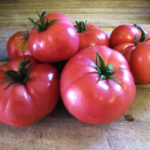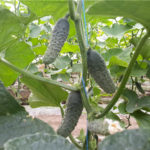Gourmet grape variety
The amateur selection of grapes, which has become active in recent decades, sometimes demonstrates very bizarre forms. Often in offspring from the same cross with a significant proportion of identical traits, their authors purposefully and intensely look for the smallest differences in order to formally announce the appearance of a new hybrid. You can understand this approach. In the end, it is a pity for any researchers, and even more so for folk breeders with their relatively modest scale of activity, to give up even a small fraction of their achievements, and therefore, under different names, seedlings are used, often similar to each other like twin brothers.
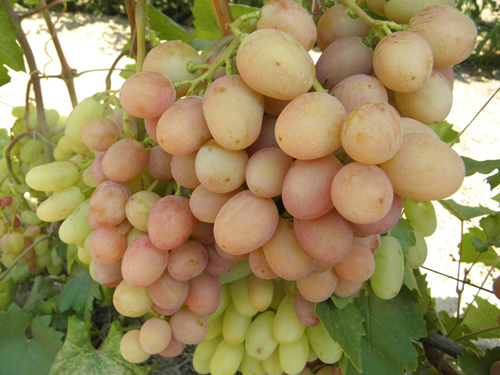
Early
A striking example of this kind is a series of "Gourmets" from the leading figure of the national national selection Viktor Krainov. At the turn of the 20th and 21st centuries, his hands created outstanding hybrid forms of grapes, which subsequently achieved unprecedented success and recognition, the best of which are the varieties of his famous "troika" - Transformation, Anniversary of Novocherkassk and Victor... Even their some growers at first did not want to recognize them in different forms, claiming a significant similarity between them. However, later the passions subsided, and two representatives of the "troika" even successfully passed the variety testing, and were officially entered into the State Register of Breeding Achievements of the Russian Federation under their own names. With the advent of Gourmets, whose number reached five, the discussion about whether to consider them the same variety, or different, flared up with renewed vigor, and continues to this day. It makes no sense to retell it; instead, it is better to reflect both their similarities and differences, so that each reader can independently assess their scale.
So, at the moment it is known about five representatives of the series: Gourmet early, G. elegant, G. gourmet, G. flashlight and G. rainbow. They all descended from the beloved Kraynow couple - grapes Mascot, selection of the All-Russian Scientific Research Institute of Viticulture and Winemaking, and Moldovan seedless variety Radiant kishmish... The result of the crossing turned out to be excellent, as always. All of them can boast of large bunches and berries, high palatability and their elegant color. Moreover, the color of the bunches is one of the few characteristics by which the originator proposed to distinguish these varieties. The difference, I must admit right away, is not always obvious, but it is, and will be described below.
Of the negative properties common to all Gourmets, only the functionally female type of flower, characteristic of all of them, can be noted. And although the author stated that they are even better pollinated than many bisexual varieties, the practice of many winegrowers has shown that problems with pollination do occur.
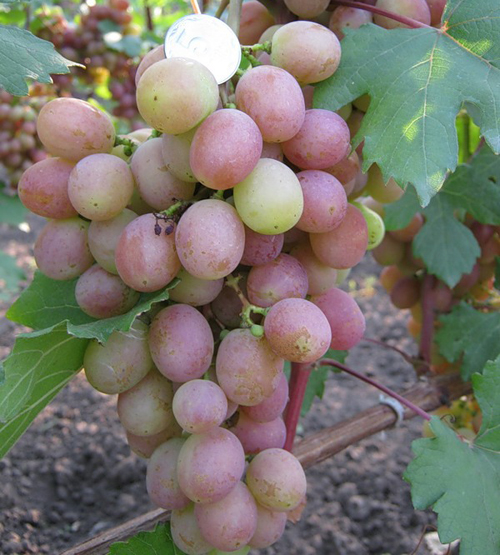
Gourmet
Agrobiological characteristics
G. early
An early ripening hybrid form of grapes with the duration of the growing season from bud break to the onset of removable maturity 115-125 days. The growth vigor of the bushes is average. Annual growth ripens well, about 2/3 of the length. Cuttings have good rooting properties.
The crown of a young shoot in the variety is green, without bright tones, but with a whitish tint due to a weak cobweb pubescence. Early Gourmet leaves are large, rounded or slightly elongated in length, three- and five-lobed, with an average degree of dissection. The surface of the leaf is reticulate-wrinkled, dark green with reddish veins. The upper lateral notches are of medium depth, open, with parallel sides, or lyre-shaped, with a rounded bottom. The lower notches are barely visible or absent. Petiole notches are found both open and closed. Petioles are of medium length, greenish-red in color. The denticles along the edge of the grape leaf are low, dome-shaped.
Flowers with a functional feminine type of flowering.Flowering, depending on the region, occurs in late May, early June. The clusters grow very large, cylindrical-conical, of moderate density, with an average weight of 500 to 1300 grams. The berries in a bunch are usually aligned, without signs of pea, oval, large in size - 25-27 mm long and 22-23 mm in diameter. The average weight of a grape is 8-10 grams. The color is very attractive - yellowish-pink with a light prune bloom of light color. The pulp density of the variety is average, the taste is pleasant with distinct nutmeg tints. The skins of grapes are of medium thickness, easy to chew and hardly noticeable when eaten.
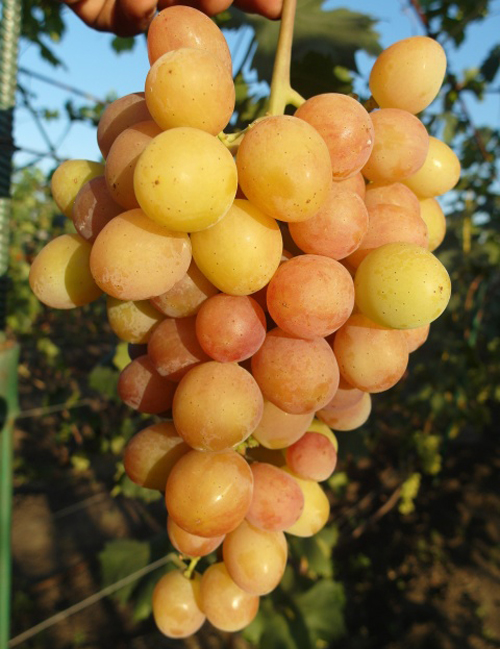
Early
The yield of the Early Gourmet is consistently high - up to 10 or more kilograms per bush with proper care. The frost resistance of the hybrid is increased, the vine can withstand temperatures down to -23 ° C without damage.
G. graceful
It has in general characteristics similar to the previous grape, differing in the morphological characteristics of the leaves, the size of the bunches and the color of the berries. So, its leaves are deeply wrinkled, rounded, slightly dissected, with V-shaped upper lateral notches, absent lower ones, and a slit-like petiole notch. Ripe conical brushes, with an average weight of 500-800 grams. The grapes are greenish-yellow in color.
G. gourmet
This variety ripens 7-10 days earlier than the previous varieties. The growing season before harvest is 105-115 days. The leaves are very similar to Gourmet graceful. At the same time, the bunch is cylindro-conical, weighing 700-1500 grams, but the berries are somewhat smaller - 20-21 by 24-25 mm in size and weighing up to 6-7 grams. The color of the fruits is yellowish-pink, and after full ripening, pinkish-lilac. The seeds in grape berries are underdeveloped, as a rule, they are represented by soft rudimentary inclusions, which determines the increased tasting ratings of this form.
G. flashlight
It is very similar to a gourmet in the absolute majority of positions, it is difficult to even guess for what reason the author singled it out as a separate hybrid.
G. rainbow
This grape has the most dissected leaf among all the representatives of the series, with a smooth surface, deep lyre-shaped lateral notches and an open vaulted petiole with a pointed bottom. The mass of the Rainbow Gourmet bunch is 600-1000 grams. The length of the berries is 30-32 mm, the diameter is 22-23 mm, the average weight is 8-10 grams. The variety ripens the last of the brethren - after 120-130 days from the moment the buds bloom.

Rainbow
All varieties have excellent taste and presentation, which is why they are mainly used for fresh consumption. Especially in this regard, Lakomka and Lantern are distinguished, demonstrating exceptional gastronomic properties due to the weak development of seeds. On the market, all forms attract the attention of buyers for the large fruit and tender color of the berries, and the nutmeg tones in the taste complement the great impression of the grapes. The rich aroma is retained even when using the crop for home canning. Compotes, juices, preserves and jams will not leave indifferent anyone who tasted them. The suitability of the collected bunches for transportation over long distances is not bad, while they can be stored without loss for only a few weeks, and even then under optimal temperature and humidity conditions.
Gourmet berries rarely crack, and only under the most unfavorable conditions, due to which they can continue to hang on the bushes for a significant period of time after ripening. The increased resistance of all varieties to gray rot also favorably affects the possibility of long-term preservation of the crop on the vine. However, due to the insufficiently thick and strong skin, damage to the grapes by wasps can occur, due to which the presentation of the crop is significantly reduced.
Agrotechnical features
Representatives of this group of hybrids belong to the category of moderately resistant to unfavorable cultivation conditions, which, in principle, determines the peculiarities of caring for them. The most significant specific factor is the female type of flowers in Gourmets, which also requires a special approach.So, when planting, they need to be placed nearby pollinator varieties. Ideally, these should be several bushes of different varieties, so that some of them will probably have the same flowering time as required. When this condition is met, natural cross-pollination by the wind, as a rule, is sufficient, and additional or artificial fertilization of functionally female inflorescences is not required. If, during the flowering period, it is rainy weather or the pollinators have pumped up the timing, there is a risk of getting loose enough bunches as a result, as evidenced by a number of winegrowers.
Gourmets do not impose special conditions on the type of soil, its fertility and mechanical composition. At the same time, generally accepted standards and requirements for planting vine plantations must be met. In particular, excessively damp, swampy soils, lowlands, slopes open to northern winds are unacceptable for culture. For an amateur vineyard, the ideal option, especially in the north, would be to plant a thermophilic crop in a wall-mounted version on the south side of any buildings that will protect the plants from cold air currents. Bushes should not be placed closer than three to four meters from trees, which dry out the soil with their root system and oppress young grapes. In the case of planting a vineyard in the phylloxera distribution zone, grafted seedlings are taken, based on phylloxera-resistant rootstocks. If this malicious pest is absent in the soil, then any variety from the representatives of the series is able to grow on its own roots, which, of course, is facilitated by their excellent rooting ability.
Own-rooted bushes of most Gourmet varieties can begin to bear fruit already in the second year, while grafted ones are usually delayed in development for a year. Early maturity also requires an early start of measures to form the skeleton of plants so that by the third year they are fully formed and ready for full-fledged fruiting. In the first season, with good growth of shoots in planted cuttings, the base of the bush is laid. In the second growing season, future arms are formed, and in the third, fruit links, giving the plants a ticket to adulthood from that moment. Subsequent annual pruning will no longer be formative, but normalizing.
In the south, where grafted seedlings are mainly used and grapes are cultivated without shelter for the winter, an additional season will be required to form a tall stem. However, such a delay will subsequently be justified a hundredfold by the magnificent harvests in volume and quality from the bushes with a significant supply of perennial wood. This method of bush management is preferable in all respects, however, it is limited by the frost resistance of Gourmets. The critical indicator for varieties of -23 ° C requires covering the vines almost everywhere, with the exception of the southernmost regions with their mild winters. As a material for this procedure, in the simplest version, they use soil from the aisles, although straw, peat, sawdust, a needle case, etc. are more reliable. moisture-permeable materials.
Plants that have entered full fruiting are annually loaded with 20-23 fruiting shoots, on which only one brush is kept, removing all unnecessary ones. To obtain such a load, taking into account a slightly different coefficient of fertility, during spring pruning, 30-40 eyes are left on the bushes, and sterile and weak shoots break off during the period of green operations. This approach allows you to simultaneously control the load and prevent the crown from thickening with useless vegetative mass.When the crop is overloaded, a number of negative symptoms may appear: poor development of shoots, lengthening of the growing season and later ripening of the crop and vines, a decrease in the taste of grapes, and, finally, the weakening of the plants themselves, which are at risk of dying in winter because of this.
Protection against diseases and pests should be carried out quite carefully, since the resistance of Gourmets does not reach the indicators of varieties tolerant to pathogens. It is especially necessary to be attentive to real powdery mildew - powdery mildew, which can cause serious damage to the crop. To combat powdery mildew, there is a wide range of drugs, both contact and systemic action. Some of them are also effective against other diseases, and even pests, which makes it possible to organize comprehensive protection based on a combination of these plant protection products. In addition, their alternation will prevent the emergence of strains of microorganisms that are resistant to a certain type of fungicide. From wasps, it is convenient, effective and safe to use individual bags for each bunch, where the grapes are safe from pests.
For particularly spectacular berries, especially those with soft seeds - Gourmet Gourmet and Flashlight, you can try experimenting with processing them during flowering with the growth stimulator Gibberellin. It is traditionally applied to varieties with a female flower type, and often has a striking effect, expressed in a significant increase in bunches and grapes, which, moreover, can be completely seedless.

